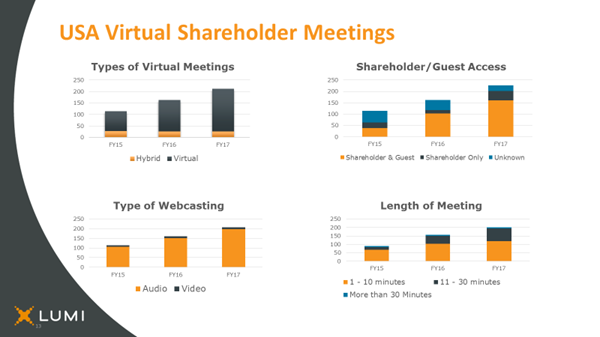While there has been a steady evolution of greater digitalisation/dematerialization in AGMs and shareholder meetings over the last couple of decades, the move to so-called virtual meetings has generated a lot of attention. The US has led the way, but other regions have seen growing interest, including adoption in the UK and Canada, as well as garnering the support of the Australian Shareholders Association. In the US, the format is commonplace (see figure 1), and the debate has moved on from whether or not to run a virtual meeting but rather how to run a virtual meeting.
Figure 1

There are questions from both investors and issuers about how this format can facilitate good corporate governance while at the same time, allowing issuers to maintain control and ensure the meeting runs smoothly.
In a recent webinar and white paper, both hosted by Computershare, this topic came up.
There has been a perception that the virtual meeting format is a trade-off between either giving issuers the ability to kill the meeting or giving investors, both retail and institutional shareholders, the opportunity to hold company boards to account. Lumi’s view is that you can have your cake and eat it too. Both of these objectives can be accommodated through virtual meetings as well as positively impacted and improved.
In a virtual or even a hybrid meeting, it is possible to facilitate more sophisticated approaches to voting and discussion in an easy-to-manage way. The question for the industry is to reach agreement on what should be the best practice. This may be different from country to country but some of the principles will be universal. Computershare’s white paper looks at how virtual and hybrid shareholder meetings and AGMs are being adopted in different markets around the world. Lumi is the main provider in many of those markets to the world’s leading transfer agents, registrars and end users.
Additionally, in expansive geographies like the US, Canada and Australia, or even where there is cross-border ownership, there are also of course cost and logistical benefits. For the issuer, they are obvious – venue rental, catering, security, staging, as well as Board travel time. The same is true for other stakeholders, whether that be shareholders, proxies, guests or press. No longer is a whole day required to navigate one meeting; institutional investors for example can now ‘attend’ multiple meetings on any given date, especially given the seasonal nature of AGMs, and bypass travel time and the related expense. With mobile ownership now surpassing that of toothbrushes, the ubiquity of smart devices furthers that convenience – an AGM in your pocket, if you will. With an estimated 97% mobile ownership among millennials and Gen-Xers, is there also an opportunity to harness this technology to involve a typically hard-to-engage demographic in corporate decision making?
Lumi has decades of experience in providing digital tools to improve a whole range of meeting types and events. As well as providing for authentication, webcast access and proxy voting and balloting protocols, technology can enable the mainstay of shareholder meetings, the Question and Answer session, to be more interactive, improving the quality of the questions from a wider base, while at the same time giving meeting organizers the tools for moderation and control to ensure the orderly conduct of the meeting. Indeed, a physical-only meeting is limited in its demographic of attendance because of logistical and cost factors. Far from restricting discussion between shareowner and board, a virtual element can make the debate far more relevant and open. Warren Buffett for example has reporters moderate Q&A at his huge Berkshire Hathaway stockholder meeting, often dubbed Woodstock for Capitalists; couple that kind of innovative approach with broad-reach virtual technology, and the contention could soon be whether access and transparency, and thus good corporate governance, is actually hampered by a physical only meeting.